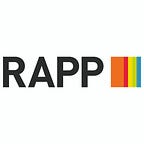Rapp to replace desks with sofas, armchairs, stools and whiteboard walls in return to office.
I had an epiphany one night recently while walking my one-year-old round the block in my pyjamas at 8pm, desperately trying to get her to sleep. The roads were deserted and calm and my little daughter was singing herself a little lullaby but I felt this pang of panic. I was going to have to go back to the office, and not just go back but lead the way back.
I was going to have to brave public transport, trust in my mask, leave the cocoon of my home. But, most importantly, I was going to have to wrench myself away from the girls, again. Maternity leave ended shortly before lockdown and this feels like a harder return. We are so used to being together day in day out…
This realisation came as we were planning the design brief for our new office space. Lockdown was even more pressured for us at Rapp and Proximity because it came as we were conducting a global merger and we had to plan our return into one shared space without even being allowed back into it!
Imagine trying to merge two businesses into one 500-people-strong agency without seeing a single employee. Not an easy task, but one that Chris Freeland (executive chairman) and I are relishing as we strive to create the agency space of the future — to remain THE best place to work in the industry despite the monumental sea chance in the way we work.
The first step was to cement what we had learned from remote working. And the first thing was that we didn’t just survive, we thrived. From a survey we conducted, we found 62% of employees felt more productive at home and 33% don’t feel any negative impact on their productivity by not being in the office. Added to this, our productivity meant we got our all time best-ever client NPS scores last month.
But as we advanced with the merger, the flaws in remote working started to emerge. Life was becoming increasingly tough for those living alone in tiny London flats with no outside space and no relatives nearby. Many people talked to me about how much they were struggling with the constant “always on” nature of video calls, no head space, and having to be visible from dawn to dusk — not all of us are made for such extrovert demands. Remote working doesn’t work for everyone.
Add to that the merger element and the difficulty of reading the sentiment of the group when you can’t see their body language. Not being able to overhear conversations in passing or have people just come over to chat at your desk, only getting to see a small number of people at a time on Microsoft Teams, and having every meeting preplanned and diarised, made instilling a robust, unified, creative culture a challenge to say the least.
Our return back together and to the office would require a distinctly different approach.
With the office space currently under refurbishment, our concept is to design a home from home. We want to create a safe, comforting, calming, happy, welcoming home environment that doubles as the office-space concept of the future. A place that every individual can feel works for them, whatever their mood or need, whether it’s collaborative-me; head-space-me; feeling buzzy-me; need inspiration-me, or socialable-me.
We’ll have workspace formats for every eventuality, including traditional desks, soundproof pods, kitchen tables, stand-up zones, café tables and even telephone booths. We also need a space big enough for all 500 of us to gather together — I cannot wait for that moment.
But crucially, our space must be somewhere people will want to leave their actual homes for.
We’ve proved remote working works and it will continue to be part of how we operate, varying by department, personality type and personal situation. But when our people are in the office (we’re planning for 70% on average) they’ve told us they’ll be coming in to collaborate as a priority and our space will reflect this.
We’ve ditched a lot of desks and replaced them with kitchen tables, sofas, armchairs, stools and whiteboard walls. We’ve bought a mountain of soft furnishings and a number of bronze pineapples (essential to the design, I’ve been told). We’re also making a living wall, a collaborative art installation and we’re not letting go of our ping pong table!
This isn’t really “a return to the office”, but more like a “work where you work best every day, any day”. Andy Rowe, our chief marketing sciences officer, says we’re in a time of adaptive strategy, and this is how we’re approaching our next iteration.
As our work and the pandemic flexes, so will we. At Rapp, we stand up for individuality so, ultimately, we’ll support every person in the organisation with whatever works for them.
Gabby Ludzker is chief executive of Rapp
This article originally ran in Campaign August, 2020.
